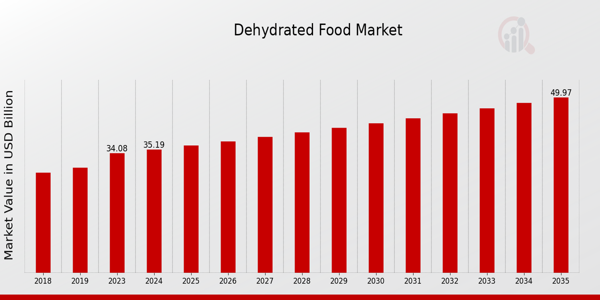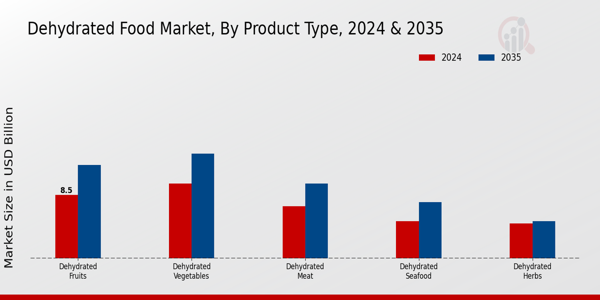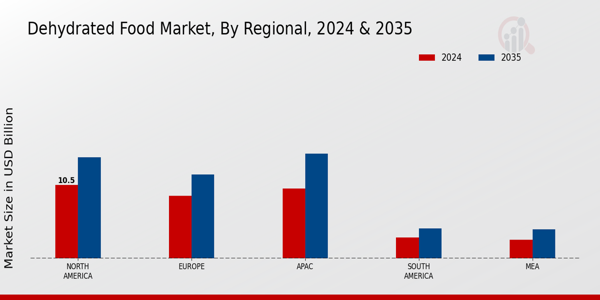Global Dehydrated Food Market Overview
Dehydrated Food Market Size was estimated at 34.08 (USD Billion) in 2023.The Dehydrated Food Market Industry is expected to grow from 35.19(USD Billion) in 2024 to 50.0 (USD Billion) by 2035. The Dehydrated Food Market CAGR (growth rate) is expected to be around 3.24% during the forecast period (2025 - 2035).

Source: Primary Research, Secondary Research, MRFR Database and Analyst Review
Key Dehydrated Food Market Trends Highlighted
The Global Dehydrated Food Market is experiencing significant growth driven by increasing consumer demand for convenience, longer shelf life, and healthier food options. With a busy lifestyle, many consumers are seeking easy-to-prepare meals that still offer nutritional benefits. The rise in the global population and urbanization is also leading to higher food consumption, pushing manufacturers toward dehydrated food products. Additionally, the growing trend of outdoor activities and travel is propelling the need for lightweight and non-perishable food items, thus creating a favorable environment for market expansion. There are numerous opportunities within the dehydrated food market that businesses can explore.Innovations in food technology can improve the quality and nutritional value of dehydrated products, making them more appealing to consumers. There is also potential for expansion in emerging markets where dietary habits are evolving. The increasing awareness of health and wellness is prompting consumers to seek organic and natural dehydrated options, allowing companies to tap into this niche segment. Sustainable practices, such as eco-friendly packaging and sourcing, can further attract environmentally conscious consumers, presenting a unique opportunity for manufacturers. Recent trends indicate a shift toward more diverse offerings in the dehydrated food sector.Innovations include unique flavors and international cuisines being introduced to cater to changing consumer preferences. The incorporation of superfoods into dehydrated products is becoming popular, reflecting a broader health consciousness among the population. Furthermore, the emergence of e-commerce has changed the landscape, allowing consumers to access a wide variety of dehydrated foods conveniently. Companies are also embracing transparency in sourcing and production, which resonates well with consumers seeking authenticity. Overall, the market is dynamically evolving, with a blend of challenges and opportunities that players must navigate strategically.
Dehydrated Food Market Drivers
Increasing Demand for Convenient Food Options
One of the primary drivers for the Global Dehydrated Food Market Industry is the increasing demand for convenient food options. As lifestyles become increasingly hectic, consumers are looking for food that not only satisfies their nutritional needs but is also quick and easy to prepare. Dehydrated foods fit this need perfectly, offering a lightweight, long-shelf-life alternative to fresh produce. The convenience factor is particularly appealing to busy professionals and families who may not have the time to cook elaborate meals.Dehydrated foods require minimal preparation; they can often be rehydrated or cooked quickly, making them an attractive option for on-the-go meals, snacks, or emergency supplies. Moreover, the rise of outdoor activities, travel, and camping has spurred interest in dehydrated foods, as they are easy to carry and store. Additionally, as global eating habits shift towards more plant-based diets, dehydrated fruits and vegetables provide a way to incorporate a variety of flavors and nutrients into daily meals without the need for extensive cooking.This trend points to a growing segment within the Global Dehydrated Food Market Industry that caters to diverse dietary needs and preferences. Therefore, the rise in demand for convenient and versatile food products is expected to heavily influence the market's trajectory and ensure steady growth in the years to come.
Rising Health Consciousness Among Consumers
Health consciousness is another significant driver for the Global Dehydrated Food Market Industry. As awareness of the benefits of a healthy diet grows, consumers are increasingly opting for foods that are less processed and rich in nutrients. Dehydrated foods, often perceived as nutritious options due to their concentration of vitamins and minerals, align well with this trend. Many dehydration methods retain the essential nutrients found in fresh foods, making them an ideal choice for health-focused consumers.Additionally, the growing popularity of various health trends, such as veganism and gluten-free diets, has led to increased demand for dehydrated fruits, vegetables and legumes. This shift creates a vibrant market for products that can meet consumer expectations for healthy eating. As a result, strong growth in this area is anticipated.
Expansion of E-commerce Platforms
The expansion of e-commerce platforms is playing a crucial role in driving the Global Dehydrated Food Market Industry. With the rise of online shopping, consumers now have greater access to a wide variety of dehydrated food products. This not only increases the visibility of these products but also encourages consumer experimentation. E-commerce platforms provide a convenient shopping experience, allowing customers to easily compare products, read reviews and receive their purchases at home.
The expansion of e-commerce is increasing the availability of dehydrated foods, thus facilitating market growth and product recognition among different segments of consumers. As a result, the e-commerce boom is improving the distribution networks for dehydrated foods, which in turn benefits companies that create personalized dehydrated food items that would not find a market in physical retail outlets.
Dehydrated Food Market Segment Insights:
Dehydrated Food Market Product Type Insights
The Global Dehydrated Food Market is characterized by a diversified Product Type segment, which prominently includes Dehydrated Fruits, Dehydrated Vegetables, Dehydrated Meat, Dehydrated Seafood and Dehydrated Herbs. As of 2024, Dehydrated Fruits holds a significant market valuation of 8.5 USD Billion, increasing to 12.5 USD Billion by 2035, reflecting the growing consumer preference for healthy and on-the-go snacking options. This segment is notable for its popularity among health-conscious consumers who are increasingly seeking nutritious alternatives.Following closely, Dehydrated Vegetables are valued at 10.0 USD Billion in 2024, with projections reaching 14.0 USD Billion by 2035. This segment is essential in providing convenient solutions for meal preparation, appealing especially to busy households and the food service industry. Dehydrated Meat, valued at 7.0 USD Billion in 2024 and forecasted to reach 10.0 USD Billion in 2035, plays a critical role in the protein market, offering shelf-stable options for consumers who prioritize high-protein diets. Conversely, Dehydrated Seafood, valued at 5.0 USD Billion in 2024, with an expected rise to 7.5 USD Billion by 2035, serves a niche market and caters to evolving culinary preferences, especially in seafood-rich diets.Lastly, Dehydrated Herbs will contribute a valuation of 4.69 USD Billion in 2024, slightly increasing to 5.0 USD Billion by 2035. This segment, while smaller in comparison, enhances the flavor profile of various dishes, capturing the interest of home cooks and professional chefs alike. The overall Global Dehydrated Food Market segmentation reveals a landscape that is driven by consumer demand for convenience, nutritional benefits, and an increasing interest in diverse food experiences, making these product types essential components of the market's growth trajectory.The majority holding of Dehydrated Vegetables and significant contributions from Dehydrated Fruits illustrate their dominance, reflecting broader trends in healthy eating and convenient meal solutions. The market continues to evolve with opportunities arising from emerging food trends, sustainability efforts and innovations in preservation techniques, solidifying the relevance of these product types within the Global Dehydrated Food Market industry.

Source: Primary Research, Secondary Research, MRFR Database and Analyst Review
Dehydrated Food Market Processing Method Insights
The Global Dehydrated Food Marketshowcases notable dynamics within the Processing Method segment, which comprises various techniques, including Air Drying, Sun Drying, Freeze Drying, Drum Drying and Microwave Drying. Among these, Air Drying holds a significant share due to its operational efficiency and cost-effectiveness, making it a popular choice for many manufacturers. Sun Drying, while traditional, remains relevant in specific regions where sunlight availability supports low-cost processing.Freeze Drying, recognized for preserving the food's texture and nutrients, is gaining traction, particularly within the premium food segment. Drum Drying is effective for thick purees and pastes, providing a unique texture to dehydrated foods, while Microwave Drying offers rapid moisture removal, catering to the demand for convenience products. As this industry continues to grow, driven by health consciousness and convenience, the diversity in Processing Methods reflects the evolving preferences of consumers, creating opportunities for innovation and expansion across the Global Dehydrated Food Market.Data reflecting the segmentation and varying techniques emphasizes the importance of adaptability within this sector to meet ever-changing market demands.
Dehydrated Food Market End Use Insights
This growth is driven by increasing consumer demand for convenient and long-lasting food options. In particular, the Food and Beverage Industry plays a crucial role, as the adoption of dehydrated ingredients enhances product shelf life while maintaining flavor and nutritional value. Retail has also emerged as a significant channel where consumers seek easy-to-prepare meal solutions, leading to rapid sales of dehydrated products.The Food Service sector leverages dehydrated foods to reduce waste and improve inventory management, making it a vital player in the market landscape. Additionally, the Household segment benefits from the convenience of dehydrated foods for everyday cooking, appealing to busy families and health-conscious individuals. As consumers prioritize shelf stability and convenience, the demand across these segments is anticipated to increase, shaping the overall dynamics and driving the market growth in the coming years. Overall, Global Dehydrated Food Market revenue is poised to experience steady expansion, reflecting the evolving preferences of consumers globally.
Dehydrated Food Market Distribution Channel Insights
Within the Distribution Channel segment, various channels such as online platforms, supermarkets, convenience stores and specialty stores contribute to the market dynamics. The online channel is gaining traction due to increasing consumer preference for e-commerce and convenience, making it a vital contributor to market growth. Supermarkets serve as an essential distribution point, featuring a wide array of dehydrated food options that attract a diverse customer base.Convenience stores cater to consumers seeking quick meal solutions, thus playing a significant role in the accessibility of dehydrated food products. Specialty stores focus on niche markets, offering unique options that appeal to health-conscious consumers. Together, these distribution channels enhance the Global Dehydrated Food Market segmentation, reflecting the evolving shopping behaviors and preferences of consumers, thereby shaping the overall market growth trajectory.
Dehydrated Food Market Regional Insights
The Global Dehydrated Food Market is expected to reach a notable valuation in the coming years, with regional dynamics playing a vital role. North America holds a prominent position with a market valuation of 10.5 USD Billion in 2024, projected to rise to 14.5 USD Billion by 2035, highlighting its significant presence in the industry. Europe follows closely, valued at 9.0 USD Billion in 2024 and anticipated to grow to 12.0 USD Billion in 2035, demonstrating a strong inclination toward healthier food options. The APAC region shows substantial growth potential as well, with a valuation of 10.0 USD Billion in 2024, increasing to 15.0 USD Billion by 2035, driven by rising dietary changes and demand for convenience food.South America, valued at 3.0 USD Billion in 2024 and projected to reach 4.3 USD Billion by 2035, showcases an emerging market opportunity despite being the smallest player in the segment. Lastly, the MEA region, with a market size of 2.69 USD Billion in 2024 and increasing to 4.2 USD Billion by 2035, reflects the growing popularity of dehydrated food products amid evolving consumer preferences. The diverse growth trajectories across these regions underline trends in market growth, challenges, and emerging opportunities in the Global Dehydrated Food Market.

Source: Primary Research, Secondary Research, MRFR Database and Analyst Review
Dehydrated Food Market Key Players and Competitive Insights:
The global dehydrated food market is experiencing significant growth due to increasing consumer demand for convenient and long-lasting food options. The market is characterized by a wide range of products, including fruits, vegetables, and ready-to-eat meals, which are dehydrated to reduce moisture and extend shelf life. Key players in this market are continuously innovating their product lines to adapt to changing consumer preferences, emphasizing quality, flavor, and nutritional value. The competitive landscape is marked by both established companies and emerging brands looking to capture market share through strategic partnerships, advancements in technology, and marketing initiatives. As the global food industry evolves, players in the dehydrated food market are leveraging these trends to enhance their competitive positioning and cater to a diverse range of consumer needs.Mondelez International has established a solid foothold in the global dehydrated food market owing to its diverse portfolio and commitment to quality. The company has successfully capitalized on the growing demand for snacks and meal solutions that are easy to prepare and consume, positioning itself as a leader in this segment. Mondelez excels in utilizing advanced dehydration techniques to produce high-quality snack options that boast extended shelf lives without compromising on flavor or nutritional content. Additionally, its robust distribution network enables Mondelez International to efficiently reach consumers across various regions, enhancing its market presence. The brand's strong focus on sustainability and innovation further strengthens its reputation and appeals to environmentally conscious consumers, ensuring its competitiveness within the dehydrated food sector.Kraft Heinz has made significant strides in the global dehydrated food market by leveraging its extensive experience and strong brand recognition. The company's product offerings include a range of dehydrated meal kits and convenience foods that cater to a variety of tastes and preferences. Kraft Heinz focuses on creating convenient meal solutions that are not only easy to prepare but also maintain the quality and taste that consumers expect. Their strong emphasis on research and development allows them to continually refine product recipes and explore new flavors that resonate with a broader audience. Moreover, Kraft Heinz's strategic marketing campaigns, coupled with its robust supply chain, enable it to compete effectively in a dynamic market environment. The company’s commitment to innovation ensures that it remains relevant amidst evolving consumer trends, reinforcing its position in the dehydrated food market.
Key Companies in the Dehydrated Food Market Include:
-
Mondelez International
-
Kraft Heinz
-
Nestle
-
Duncan Hines
-
Associated British Foods
-
Dole Food Company
-
Unilever
-
Drying Corporation
-
Hain Celestial Group
-
General Mills
-
Bunge Limited
-
ConAgra Foods
-
Olam International
-
Kewpie Corporation
-
Pillsbury
Dehydrated Food Market Industry Developments
Recent developments in the Global Dehydrated Food Market highlight significant growth and increased investments from major players such as Mondelez International, Kraft Heinz, and Nestle, all of whom are expanding their offerings to meet rising consumer demand for convenient and long-lasting food products. The market is witnessing trends driven by health-conscious consumers, leading to the introduction of organic and natural dehydrated food options.
Additionally, the recent merger between Unilever and Hain Celestial Group marks a strategic move to enhance product lines and distribution channels within the dehydrated food segment, aiming to capture a larger share of the market. Companies like General Mills and ConAgra Foods are also investing in innovative processing technologies to improve product quality and shelf-life, contributing to market valuation growth. Furthermore, Dole Food Company has been actively working on sustainability initiatives, which are becoming increasingly important in consumer purchasing decisions. This heightened focus on sustainability, coupled with technological advancements and increased collaborative efforts across the industry, is significantly impacting the overall market landscape, ensuring robust development and a competitive edge among leading companies.
Dehydrated Food Market Segmentation Insights
Dehydrated Food Market Report Scope
| Report Attribute/Metric |
Details |
| Market Size 2023 |
34.08(USD Billion) |
| Market Size 2024 |
35.19(USD Billion) |
| Market Size 2035 |
50.0(USD Billion) |
| Compound Annual Growth Rate (CAGR) |
3.24% (2025 - 2035) |
| Report Coverage |
Revenue Forecast, Competitive Landscape, Growth Factors, and Trends |
| Base Year |
2024 |
| Market Forecast Period |
2025 - 2035 |
| Historical Data |
2019 - 2024 |
| Market Forecast Units |
USD Billion |
| Key Companies Profiled |
Mondelez International, Kraft Heinz, Nestle, Duncan Hines, Associated British Foods, Dole Food Company, Unilever, Drying Corporation, Hain Celestial Group, General Mills, Bunge Limited, ConAgra Foods, Olam International, Kewpie Corporation, Pillsbury |
| Segments Covered |
Product Type, Processing Method, End Use, Distribution Channel, Regional |
| Key Market Opportunities |
Rising demand for convenience foods, Growth in online retailing, Expansion in health-conscious consumers, Increasing popularity of plant-based diets, Advancements in dehydration technologies |
| Key Market Dynamics |
Rising health consciousness, Increasing convenience demand, Expanding distribution channels, Technological advancements in dehydration, Growing tourism and outdoor activities |
| Countries Covered |
North America, Europe, APAC, South America, MEA |
Frequently Asked Questions (FAQ) :
The Global Dehydrated Food Market was expected to be valued at 35.19 USD Billion in 2024.
By 2035, the Global Dehydrated Food Market is anticipated to reach a value of 50.0 USD Billion.
The expected CAGR for the Global Dehydrated Food Market from 2025 to 2035 is 3.24%.
North America is expected to dominate the Global Dehydrated Food Market with a value of 10.5 USD Billion in 2024.
The projected market size for Dehydrated Fruits is expected to be 12.5 USD Billion in 2035.
Key players in the Global Dehydrated Food Market include Mondelez International, Kraft Heinz, and Nestle, among others.
The market size for Dehydrated Vegetables is valued at 10.0 USD Billion in 2024.
The Dehydrated Meat segment is projected to grow significantly, reaching 10.0 USD Billion by 2035.
The expected market value for the MEA region in 2024 was 2.69 USD Billion.
The market for Dehydrated Herbs is expected to grow to 5.0 USD Billion by 2035.

















